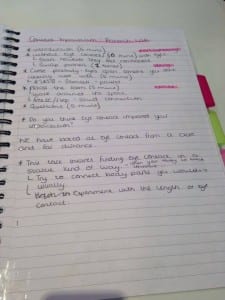Our last contact lesson had finally began. When I think back to the beginning of the process, its amazing to think how far I have come as an individual. But also I think it is interesting to look at how far we have come as a class. We went from not even wanting to touch each other, to rolling on top of each other experimenting what our bodies could do. I no longer feel negative feelings towards Contact Improvisation and I have actually enjoyed the practice that we are going through!
The class started with the showing of our individual duets which we had been choreographing over the past few weeks. I was beyond nervous to see what everyone had come up with, but also to make sure that mine and Anna’s duet actually went according to plan! Choreographing these duets I found to be very difficult, if me and Anna improvised something that worked, sometimes we then couldn’t remember what we had done afterwards. This was tricky as it meant for a long time our duet was in two sections and we struggled immensely to join them together. I am very pleased with how the duet came out overall however and I really enjoyed working with Anna as I feel we have similar movement styles to each other. I liked the performance of our duet and I was impressed that everything did go to plan, and we executed everything that we set out to. I also really enjoyed watching everyone else’s duo’s, they were all so varied. Its impressive to see how far we have come from the beginning of the process to the end.
After we had showed the duets, we had to discuss Nancy Stark- Smith’s score, and the elements that she believes go into a contact improvisation jam. Kirsty gave each research group 3 symbols/ words from the score and we had to explain what they were with a practical showing too. The words my group received were, Divergence, Influence and Collision.
Divergence: We thought this to mean going with intention towards someone and then curving away at the last second, as not to touch the other person.
Influence: We thought this to mean, being open to let someone else control your movement, for example you could mimic someone’s movement. Another example of this could be getting in a dancers way, so you are influencing where that person has to move.
Collision: The definition of this was simple, crashing into someone! But in contact it comes down to how you react to this collision, do you work with it or do you move away from it?
We then moved onto a Nancy Stark- Smith score. I was nervous about going into this having only just learnt what the score was about! I also wasn’t sure if I could remember what each word/symbol was in the jam. As we started with a discussion and a bit of a pow-wow about what we were about to do I suddenly felt more confident. I knew a lot more terms than I thought I would. I really enjoyed participating in this score, it had freedom but at the same time structure. I found myself making strong connections with a lot of people, something that before I was never very good at.
Time went surprisingly fast for me, at one point me and Zoe were improvising for what seemed like a very long time. We were bringing different parts of movement into the score and we began to play with dynamics and pace. This felt really smooth for me, there was no real thinking about what movement might come next. That is always what I have experienced before and I enjoyed not having to think about what I was doing, just going where the movement takes us. I also played with counter balance and lifts in this score more than I ever have before. Lifts were coming smoothly and I really enjoyed how that felt in my body. The sound section was something that I think I will always find awkward. Making noise to go with movement has never been something which comes naturally to me, and I am glad that every movement I made I tried to make some sort of noise with. As the score slowed down, there was a humming section which everyone joined in with at the end! This is something we would have never done in the beginning, whereas now no one was scared to get stuck in and it meant the atmosphere immediately relaxed as everyone joined in!
Contact improvisation for me is now something that I will not shy away from. This module has taught me that I can do things that previously I would have thought would be next to impossible for me to achieve. I enjoy taking part in jams and I hope it is something I can take up in the future.
